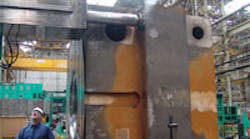Davy Markham, of Sheffield, England, manufactures heavy equipment, including critical equipment, such as large press components, rolling mill stands, bridge components, offshore structure nodes, nuclear fuel storage and handling equipment, gas and steam turbine casings, and various other typically large-scale products. Ferrous castings weighing several hundred tons are common in their work orders.
And yet, in terms of finishing tolerances, the standards for these designs typically is much, much smaller in scale— often just a few microns. In some cases, these products require more than 1,000 machining hours to achieve the necessary finished tolerance. Sometimes it may take days just to turn a casting over in order to machine a different face.
Therefore, time saved in the machining effort can be advantageous to the total cost of a project. John Watson, Davy Markham’s production manager says: “Improving cutting tool performance is a major factor in our drive to deliver our Total Punctuality Concept, whereby everything we do is delivered on time, every time.” Because of the difficulties of machining large castings, Davy Markham enlisted Luxembourg-based Ceratizit S.A. (www.ceratizit.com) to investigate improvements to its finish milling tools and process.
Ceratizit is the result of a 2002 merger between Cerametal and Plansee Tizit, and calls itself a pioneer in sophisticated hard-material products. In some industrial segments, Ceratzit’s Plansee group is the global leader in hard-material products for wear protection and cutting tools. Its products are critical supplies to the automotive industry, mechanical engineering operations, and mold and die producers, among other manufacturers. The group has 400 active patents and 4,000 employees worldwide.
The assignment by Davy Markham was a statement of confidence in the carbide experts, because its products cannot be experimental objects; the time and investments they represent mean that every attempt at improvement must have immediate impact.
“Initially we saw an opportunity to develop the existing process,” states Adrian Eagle, Ceratizit’s cutting tool account manager. “The original milling cutters were designed as a double-negative cutter, which is not ideal for a finishing operation. Therefore, we designed a cutter with a 45° approach angle and a positive rake. The effect this had was to improve cutting data on the 250-mm diameter cutters dramatically.”
The feed rate was immediately increased from 400 mm/min to 1,200 mm/min, with the potential to take this even higher, and all this with only one tool. This finishing cutter can be applied for the typical average medium cuts at Davy Markham (depth of cut up 6-8 mm), then a finishing operation at 0.1 mm follows.
Once the finishing cutters had proved their worth, Ceratizit was assigned to the roughing operations. “The biggest challenge facing Ceratizit in this area was one of consistent metal removal,” recalls Kevin Parkin, managing director of Davy Markham. “Due to the scale of the castings being machined we are often faced with sand inclusions and differential hardness of the cast material. The goal is that any tool design must be able to absorb these material changes without the requirement to adjust speeds and feeds.”
In response to this problem, Ceratizit developed a customized tool design. It is a negative-rake cutter body that uses a non-standard insert to provide multiple cutting edges, in consideration of the fact that with these finishing cutters swarf removal is a significant operating concern. Ceratizit developed specific insert geometry designs to ensure that chip breaking is achieved in a controlled manner. This is achieved by the specific land and edge preparation undertaken on the inserts.
“Heavy industry is often viewed as very traditional and reluctant to change,” says managing director Kevin Parkin. “However, we had to make these changes in order to compete with low-cost economies around the globe. In the past 18 months we have focused our efforts on being a ‘customer-facing’ business, and have implemented a 100% on-time delivery program to ensure that we continue to win repeat business.”
This strategy has created a full order book for Davy Markham. “Crucial to this strategy are the partnerships that we have with our suppliers,” states Parkin. “In the past we have had what can be described as passive relationships with tooling suppliers. What we now have with Ceratizit as a partner is a very professional relationship.”











